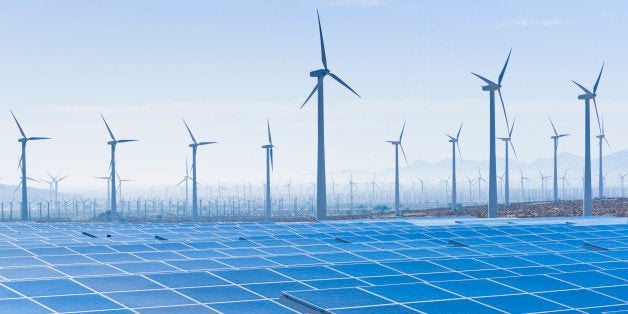
The prospects of Elon Musk's Solar City colossus are in a state of constant flux, with announcements of pathbreaking technological advances one month and record-setting losses the next. Musk's fortunes mirror instabilities in the energy market as a whole, where volatile oil and gas prices have reduced once-solid bets on unconventional extraction practices in the Canadian tar sands and American fracking fields to something far less certain.
If today's energy markets are hazy, the long-term picture is less so. With the exigencies of climate change bearing down and the efficiencies of solar and other renewables rising, the world, to the dismay of Big Oil and Gas, is inching toward a renewable revolution. Clean energy technology, long seen in much of the U.S. as the fool's errand of California communes and well-meaning liberals with cash to burn, now threatens the entire fossil fuel establishment. According to United Nations statistics, global renewable energy investment increased by $270 billion, or 17 percent, last year alone.
The most immediate challenge posed by the rapid scaling of solar is to electric utilities and their coal, gas and nuclear generation partners. The combination of falling solar installation costs, improved battery management systems and an electricity grid in need of a costly upgrade portends a future of distributed generation, in which residential and other localized renewable facilities would produce for a hyper-local market. The future is now, with microgrids under construction on college campuses like UCSD and Illinois Institute for Technology and in communities across the country.
Electric utilities that have long resisted the new regime of renewably-powered distributed generation are now hedging their bets. Con Edison is working with community organizations in Brownsville, Brooklyn to build a solar district. The leviathan NRG, whose profits have been drawn from fossil fuels for decades, made a big splash this year with an aggressive ad campaign for its residential solar program, but now appears to be retreating to its familiar carbon-centric model.
The implications of the renewable revolution reach far beyond the confines of energy markets. If the last half-century was the Age of Cheney, with resource wars raging across the globe and corporate campaigns against rational climate policy, the new world of localized, renewable generation and grid management is its antithesis.
The gold standard of achievement in distributed generation is Germany, where feed-in tariffs set stable prices for residential and commercial producers. The results have been staggering, with more than 25 percent of German electricity now produced renewably and the goal of 40% by 2025 in sight. This compares to 13 percent for the United States. Perhaps most impressive is that about half of renewable energy generated in Germany is owned by citizens, through rooftop installations and co-operatives.
Closer to home, California provides a glimpse of the future, which saw $11.7 billion in solar investment in 2014 and is on the cusp of becoming the first state with 10 MW of installed capacity. According to a solar industry association, California now produces ten times as much solar energy as the entire country did just eight years ago.
But the rosy future of decentralized power generation, democratic ownership and diminished energy imperialism, which together form the core principles of the rising Energy Democracy movement, is not assured. It faces opposition from the vested carbon interests and new corporate formations built on centralized control of the emerging renewable sector.
The battle over the way forward is playing out now in New York State, where Governor Cuomo and the state's energy agencies set in motion a formal Reforming the Energy Vision (REV) process in 2014 to consider the big questions swirling around the fading electric utility. The REV has become a magnet for energy interests and visionaries of all stripes, from libertarians who imagine a self-regulating, decentralized trading platform that would serve as a clearinghouse for market participants large and small to utilities who are set on dressing up monopoly generation and distribution as something new.
A coalition of community-based organizations, the New York State Energy Democracy Alliance, has coalesced to call for making REV "REAL": Renewable, Equitable, Accountable and Local. A progressive REV would include clear and enforceable targets for renewable generation and greenhouse gas emission reduction; a new, decentralized and transparent market regulated by a publicly accountable institution responsible for establishing high road economic development standards for market participants; policies like community-net metering that promote ownership of renewables by the widest swath of citizens; and deep, holistic investments in energy efficiency, renewables and green job training pathways that are targeted to frontline communities and low-income communities of color.
The movement for a REAL REV is inspired by the victory of a grassroots movement in California, led by groups like APEN and CEJA, that won a commitment of 25 percent of revenues from the state's cap-and-trade program, amounting to $500 million per year for energy-related projects in low-income communities. The New York Alliance won an early victory last month when the state's Public Service Commission ordered the creation of a community distributed generation (CDG) program with goals around low income participation. The new CDG program will enable the development of shared renewable energy projects that directly benefit low income residents unable to participate in the rooftop solar revolution because of poor site conditions or their status as renters. The program also promises to open the door to cooperative ownership and community wealth building opportunities for these same communities.
Reforming the Energy Vision in New York is a prelude to the Clean Power Plan processes that will soon be underway in most states as part of the compliance process for the EPA's 111(d) rule. With the energy sector in transition, the new rules are being written as we speak, and all of us need to be in the room this time around.